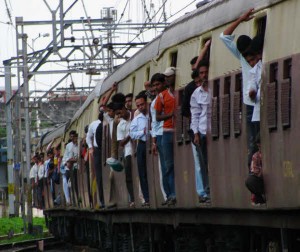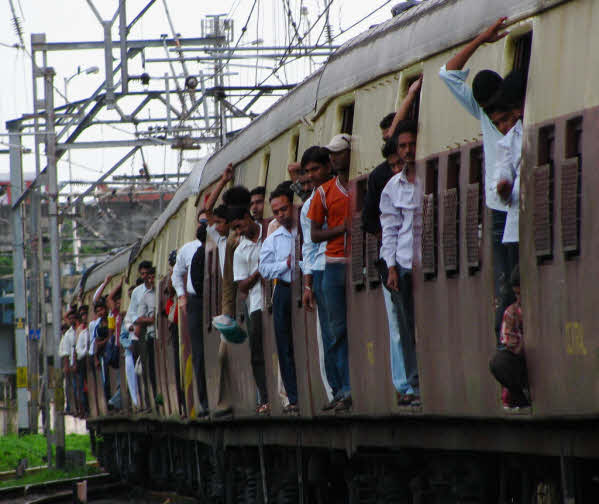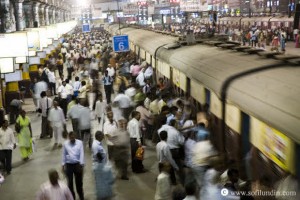by Balaji Iyer
[box]Local trains in Mumbai are notorious across the world for their crazy crowds. They’re an institution, really. Balaji Iyer personifies the famed Mumbai ‘locals’ and gives us an insider’s perspective on what getting into a train in the morning entails and how one can survive without getting delayed, thrown out or run over![/box]Much has been written on surviving the great Mumbai locals. Guidebooks offer helpful tips on everything from kalaripayattu maneuvers to chopping yams in the 6:23 fast. What can daily commuters add to this hallowed pool of knowledge? Travelling to CST in the mornings (from anywhere, unless you live in South Mumbai polishing off your platinum plates and picking out Prada slippers, in which case this is merely a bedtime horror tale for you) is a struggle of epic proportions. Morning locals to the city aren’t just crowded, they are ‘jam packed’ – to use a nifty Mumbai phrase. But only experts like me (or my mother, father, grandmother, seven great aunts, cousins, friends and our household help) truly possess that special knowledge; knowledge that elevates the commute to a science. Almost to an art.

The fact that if you miss the 8:19, the next train you could take is the 8:38. Despite the nineteen minutes in between. This is because the 8:21 is a fast local and even superman cannot make it to platform seven from platform one in two minutes. The 8:23 ought to come on platform four, but it always arrives a minute later on platform six and turns into a fast local. The 8:28 is perfect; it arrives on platform four, isn’t very crowded (in mumbaispeak this means that you would make it to your destination in one piece) but it is the ladies’ special. Generations of men have heard horror stories of unwary (and wary) college boys getting their eyes gouged out, or vital parts kicked in while attempting to board the 8:28. The 8:32 then, obviously is the bastion of the wary boys, unwary boys and harried gentlemen. Not to say that the pretty ladies don’t make a dash for it. After all there are three ladies compartments and a miniscule space masquerading as a first class ladies compartment. Reason enough to not go within spitting distance of it. The 8:36 is a slow local that suddenly becomes a fast or a fast that becomes slow, no one knows. Hence it is best avoided. The trilingual announcements aren’t of much help because the very inconsiderate announcers also speak of long distance trains arriving or departing and of outbound locals. Sheer nonsense of course, but in Mumbai who has time to reprimand even idiots? So then you stand about on platform one reading a newspaper, or your favourite book, or listen to music (none of which you could do in a local train anyway. I once saw a man attempt to read his Times of India on the 7:59; when he got off at CST, the paper didn’t exist. Neither did parts of his shirt and nose).
The 8:38 then arrives, pulling into the station slowly, almost regally, albeit with people hanging out of it. As it pulls abreast of the platform, you hear thousand claps of a million descending feet. It is an ordered cacophony. The hard thwacks are of daily wage labourers, their hawaii chappals hitting the concrete as they sprint, and triumphantly get off the train. The duller thuds are of shoes hitting the concrete, office going men and college boys. Clacks are ladies’ sandals, clicks are college girl’s fancy footwear and flat slaps are fisherwomen’s baskets hitting the platform, the smell of Mumbai following in their wake. Meanwhile people are already clambering onto the local. Women hit, slap and fight with furious frenzy, men jump into the train with precise, calculated movements, but all the seats within are already occupied. Those with seats have an all knowing smile plastered onto their faces and those without seats waste no time in finding the perfect spot to stand. Decades of commuting have established rules for standees, those wishing to get off at CST stand furthest inside, almost on the laps of the seated; for Dadar: in limbo; neither near the seats nor the door; the rest: simply filling in, like so many directionless ants.
The daily commuter of course knows all of this (so much for my secret knowledge!). Why then, do I spend minutes waiting? Isn’t time money? Everyone is taught that in Mumbai 101. What everyone doesn’t know is that the 8:21 needs to change tracks after Vikhroli, which means it stops for a full three minutes at that god forsaken station. The 8:36 must restrict its speed, lest it ram into the 6366, but cannot go too slow lest the 3633 ram into it. The ladies’ special of course, being a womanly affair runs perfectly on time. But that is not in the scope of today’s discussion.
Getting into the train isn’t all kung–fu, there is a surprising amount of logic involved as well. Within a train too, some compartments are more equal than others. First class ones, then also the coveted ones – that stop directly in front of the foot over bridge at your destination. For tired men – the compartment adjacent to the ladies first class. The view is superb.
Pics : unlisted sightings – http://www.flickr.com/photos/unlistedsightings/
sofi lundin – http://www.flickr.com/photos/sofi_lundin/
[box type=”info”]DID YOU KNOW? The post you just read is also a part of a PDF that looks just like a magazine in print and can be downloaded? Well, we also have another option that lets you flip and read the issue like a magazine. It’s so full of colours and the best part is you have all the contributions in one place! Take our word for it and don’t miss it. Click on the buttons below to access the same![/box] [button link=” https://sparkthemagazine.com/wp-content/uploads/2011/04/Spark-April-2011.pdf” color=”orange”]click here to download the april 2011 issue as a PDF.[/button] [button link=”http://issuu.com/sparkeditor/docs/spark-april-2011?mode=embed&layout=http%3A%2F%2Fskin.issuu.com%2Fv%2Fcolor%2Flayout.xml&backgroundColor=000000&showFlipBtn=true” color=”red”]click here to flip and read the april 2011 issue like a magazine[/button] [facebook]share[/facebook] [retweet]tweet[/retweet]





